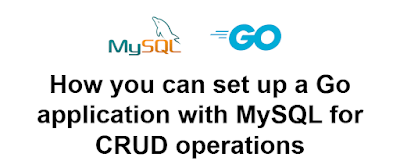How you can set up a Go application with MySQL for CRUD operations
To create a simple web CRUD application in Go (Golang) that interacts with MySQL, you need to perform several steps. Below is a basic example of how you can set up a Go application with MySQL for CRUD operations.
Prerequisites
- Go Installed: Make sure you have Go installed.
- MySQL Database: You should have a MySQL server running and a database set up for storing data.
- Go MySQL Driver: You need to install the MySQL driver for Go, which is
github.com/go-sql-driver/mysql.
Steps to Create a Golang CRUD Application with MySQL
1. Install MySQL Driver
First, install the MySQL driver for Go:
2. Set Up MySQL Database
In MySQL, create a database and a table. Here’s an example:
3. Create Go Application
Now, let's create a Go application to perform CRUD operations.
Directory Structure:
Code for main.go:
4. Explanation of the Code:
- Database Connection: The
init()function sets up the connection to the MySQL database using thesql.Openfunction. - HTTP Handlers:
/create: HandlesPOSTrequests to insert new users./read: HandlesGETrequests to fetch all users./update: HandlesPOSTrequests to update a user's information./delete: HandlesPOSTrequests to delete a user by their ID.
5. Running the Application
Start the server:
The application will run on
http://localhost:8080. You can use tools likecurlor Postman to interact with the endpoints.
6. Testing the Application
Create a User:
Read Users:
Update a User:
Delete a User:
This simple Golang application demonstrates how to create a basic web API with CRUD operations connected to a MySQL database. You can extend it with more features, such as better error handling, form validation, and using more advanced frameworks like Gin or Echo.









